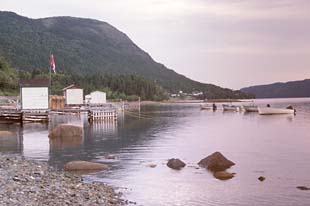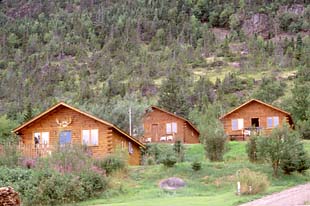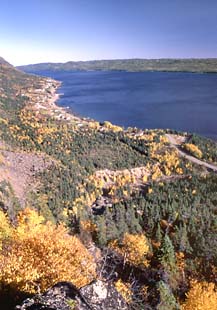|
|
"Nestled close to King's Point, near the bottom of Green Bay's Southwest Arm, is the community known as Rattling Brook. Rugged sheltering cliffs, pastoral valleys, and a majestic waterfall made this an appealing place to settle. Of course, this natural attractiveness would not have been enough to win over a people who were forced to consider more practical matters."
|

|
|
"Fairly good fishing grounds and fertile soil made it easy for the original settlers to meet their basic needs though, and local history was set in motion. Rattling Brook's earliest white habitation started in the late 1800's at a place near the falls known as Corner Brook Cove. The first man to bring his family to the present day site of the community was Jessie Newhook, who travelled down from Jackson's Cove, near the mouth of the arm. A generous amount of flat land with productive soil made agriculture an important industry in Rattling Brook. Farming provided food for families in the community, as well as money. The portion of crops not needed for local consumption was sold to people in Tilt Cove, Nipper's Harbour and other nearby communities.
By 1911 the population of Rattling Brook was 112, with most residents kept busy farming and fishing, and eight people engaged in mining. Today there are around 150 people in the town."
"Fishing was an important industry during the summer months. Scotch fishing - a particular way of salting herring, and smoking fish, created food and money, in exchange for surplus supplies. Since the pickled herring required containers for it to be stored in, the spinoff industry of barrel making soon came into existence as well.
Like many other communities in the 30's, Rattling Brook also felt the effects of the depression. Men would snare and sell rabbits for 25 cents a pair. Those who went after rabbit were often away in the woods for two weeks at a time. This absence was hard on families, however it provided the funds necessary to keep body and soul together. A rabbit factory was also established at this time to handle the abundance of animals being taken.
Lumbering was another business that created work for residents. Some moved inland to work for logging companies. Others stayed in Rattling Brook cutting lumber for their own use and to be sold in St. John's.
Local resident Frank Bartlett also helped to create much needed jobs during the depression years. He started a boat building operation in 1929. Usually, eight men would be engaged to build each schooner while eight more would be needed to gather materials for the construction of each vessel. These labourers would receive the incredible wage of $1.50 a day. Over a 12 year period, ten boats were completed and at that time Rattling Brook was one of the few areas in Newfoundland that was building schooners on a continual basis. Some of the boats built locally were as follows: the Dawson City, the Dayton City, the Audrey Bartlett, the Arizona and the Tempest."
Excerpts from Moments in Time, (Green Bay Economic Development Association 1994).
|










